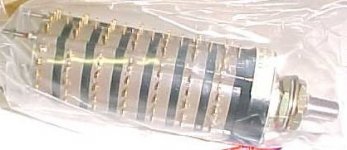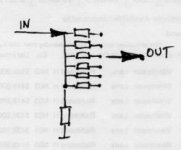I have a few extra Grayhill 7 pole, 7 deck, 20 position rotary switches for sale at $25/ea.These are Mil Spec sealed switches with a 1/4" flatted shaft. I can take paypal. Add $3 for US shipping.
does non-shorting just means that it breaks connection before changing to the next switch setting, in comparison to shorting, which connects before disconnecting. Is this correct? So, non-shorting switches create a bad "pop" when channels, right? Is there anyway to avoid this problem?
--
Brian
--
Brian
Shorting switches are used for volume control, and when changing level you would get uninterupted signal without pops.
Non-shorting switch can't be used as a shunt element in volume control, because it brakes to ground connection and ea. time it creates maximum signal level.
I imagine the only way to change it for shorting type switch is to change the wiper. But there are 7 of them and it's almost watch makers precision job.😉
Nevertheless, those are fine switches and I'm seriously considering getting one for myself.
Non-shorting switch can't be used as a shunt element in volume control, because it brakes to ground connection and ea. time it creates maximum signal level.
I imagine the only way to change it for shorting type switch is to change the wiper. But there are 7 of them and it's almost watch makers precision job.😉
Nevertheless, those are fine switches and I'm seriously considering getting one for myself.
Peter Daniel said:Shorting switches are used for volume control, and when changing level you would get uninterupted signal without pops.
Non-shorting switch can't be used as a shunt element in volume control, because it brakes to ground connection and ea. time it creates maximum signal level.
Could you just wire the ground connection to the switch differently to get rid of this problem? You would still get an interrupted signal, but you could get rid of the pops. You could tie the ground to the lowest volume level of the switch. Would this work?
--
Brian
The problem is that when the switch pole is in between positions and making contact with nothing, there is no shunt element in the circuit. The signal volume shoots up to maximum every time you rotate the switch one position.
It is possible to switch the series resistance, as opposed to the shunt resistance but many purists would be aghast at this idea because it put all the resistors and as many solder joints directly in the signal path, so they say. They do forget, however, that if this were a shorting switch using the typical configuration, all the resistors and solder joints are still in the signal path.
Whoever it was that first said than a shunt to ground is not in the signal path has been watching too much television.
It is possible to switch the series resistance, as opposed to the shunt resistance but many purists would be aghast at this idea because it put all the resistors and as many solder joints directly in the signal path, so they say. They do forget, however, that if this were a shorting switch using the typical configuration, all the resistors and solder joints are still in the signal path.
Whoever it was that first said than a shunt to ground is not in the signal path has been watching too much television.
One could use it like that: fixed resistor to ground and switched series element. Since only one resistor is always connected, purists don't have much to complain and it can be used for up to seven independent channels. Also, no signal volume shoots up to maximum every time you rotate the switch, because shunt resistor is connected permanetly.
Attachments
Peter Daniel said:One could use it like that: fixed resistor to ground and switched series element. Since only one resistor is always connected, purists don't have much to complain and it can be used for up to seven independent channels. Also, no signal volume shoots up to maximum every time you rotate the switch, because shunt resistor is connected permanetly.
Wouldn't that limit the range of your volume control, and if not, wouldn't it still get damn loud when it has no connection when switching? That is what I was thinking of earlier when I posted, but I don't see how it would work well?
--
Brian
I don't think it would limit the range any more than fixed series element and switched shunt resistor (this is what I'm using currently). If no conection when switching, there is no signal at all because of an open circuit.
ROTARIES
Hi,
And this is exactly how I build these for attenuating the signal in a tube preamp.
When the next stage uses a fixed gridresistor to bias that tube it is important not to shunt it since that would change the tubes' operating point.
Since you put only one resistor and one contact in series with the signal it is also the most "purist" approach.
See also:
http://www.diyaudio.com/forums/showthread.php?s=&threadid=6847
Ciao,😉
Hi,
One could use it like that: fixed resistor to ground and switched series element. Since only one resistor is always connected, purists don't have much to complain and it can be used for up to seven independent channels. Also, no signal volume shoots up to maximum every time you rotate the switch, because shunt resistor is connected permanetly.
And this is exactly how I build these for attenuating the signal in a tube preamp.
When the next stage uses a fixed gridresistor to bias that tube it is important not to shunt it since that would change the tubes' operating point.
Since you put only one resistor and one contact in series with the signal it is also the most "purist" approach.
See also:
http://www.diyaudio.com/forums/showthread.php?s=&threadid=6847
Ciao,😉
One other thing; it may seem that 20 positions might not be enough, but I'm using 24 positions Elma and in fact, I'm mostly switching between 6 positions anyway.
POS USED.
Hello,
Yep.
And that is where I spend money on resistors.😎
Ciao,😉
Hello,
I'm mostly switching between 6 positions anyway.
Yep.
And that is where I spend money on resistors.😎
Ciao,😉
- Status
- Not open for further replies.

